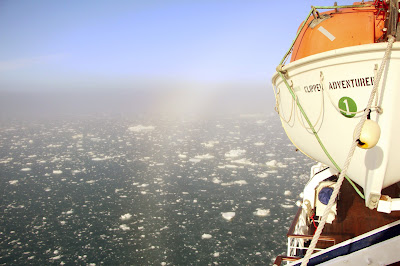TODAY was all about ice.
Not the
kind you find cooling your gin and tonic, but the type that floats in these
northern waters and was responsible for taking down the Titanic.
This
morning, as the captain made for the settlement of Ilulissat on Greenland's
rugged west coast, we came across the first ice of the expedition and everyone
flocked onto the decks to see the pieces of white dotting the surface all the
way to the horizon.
Soon these small rocks were replaced by a carpet of white with chunks of all sizes - from blocks the size of a portable television to slabs as big as a block of flats - which forced the captain to show right down to pick a path between the pieces.
While it was a clear day there was a layer of fog just above the surface which made all the shades of blue blur into each other and I often couldn't tell where the sea finished and the sky started.
As we apprached Ilulissat the pieces were replaced by vast islands of ice that looked like an extension of the land, and soon we could see the colourful buildings that line this part of the Greenland coast emerge from the mist.
Captain Grankvist dropped the ship's speed to seven knots, and then again to three knots as we drifted close to the land, and those on deck could see there were islands hidden behind the boulders of frozen water.
Some of the bergs were dirty and one of the expedition staff standing close to me on the rail explained the black side was once the bottom of the block, with the dirt attaching itself as the piece slid slowly down the glacier, and the underside exposed when enough evapouration happened to capsize the floating mountain.
The ice
was so dense near land it took a couple of extra hours to reach the port, and
even then a zodiac was launched so two epedition staffers could physically push away the
blocks preventing the ship getting close enough to the wharf to tie up and drop
the gangway.
The original plan was to walk to a vantage point providing a view across the Ilulissat Icefjord, so we could see the new icebergs dropping away from the glacier in a process called calving, but because we arrived so late we were asked to stay close to the ship.
There was
time for a quick peek at town and then it was back to the ship to explore the
ice by zodiac.
Dressed
in our warmest expedition attire we climbed into the little boats and headed
back out into the harbour with the zodiac running aground on several occasions
when a clear path through the white surface couldn't be found.
The ice
scraped and groaned as the zodiac pushed past, making a rubbery sound when it
brushed against the hull and a more leathery sound when forced against another
piece of frozen water.
Floating around in all the ice, so close to the surface, is something I will always remember.
And the view from the zodiac also showed us just what a good job Captain Grankvist had done getting the Clipper Adventurer beside the wharf after the slow journey into Ilulissat this morning.
Floating around in all the ice, so close to the surface, is something I will always remember.
And the view from the zodiac also showed us just what a good job Captain Grankvist had done getting the Clipper Adventurer beside the wharf after the slow journey into Ilulissat this morning.






























